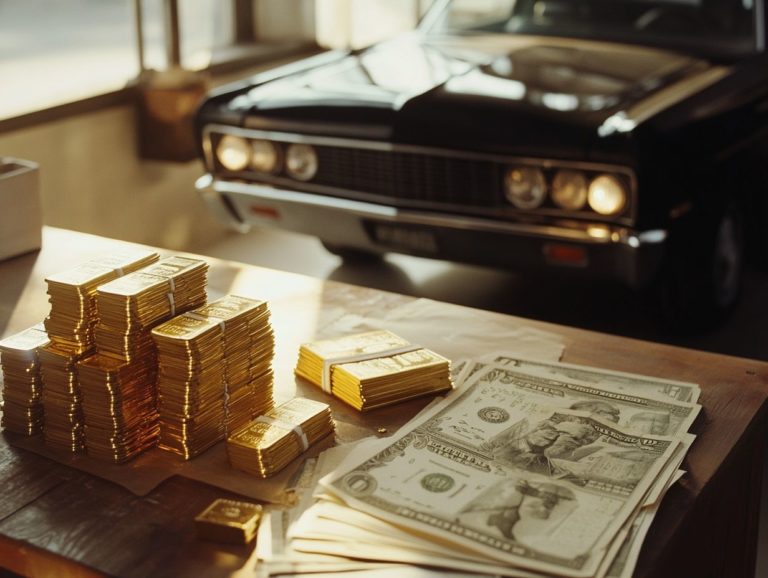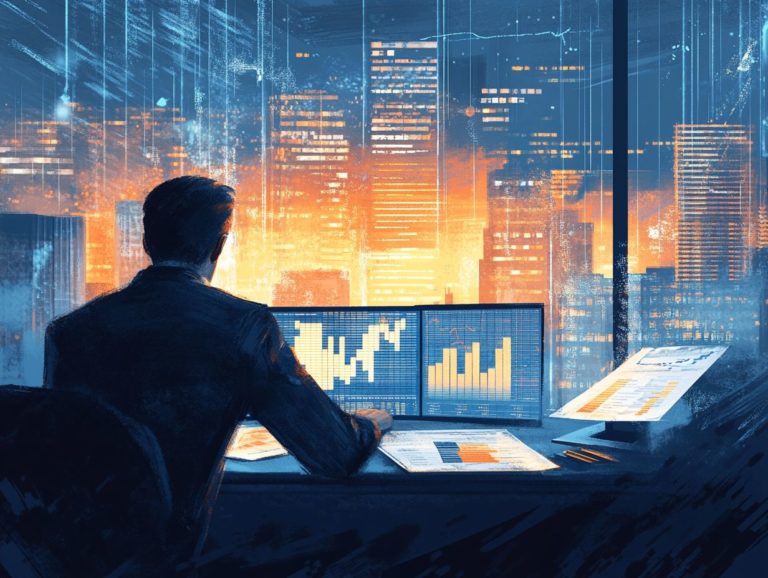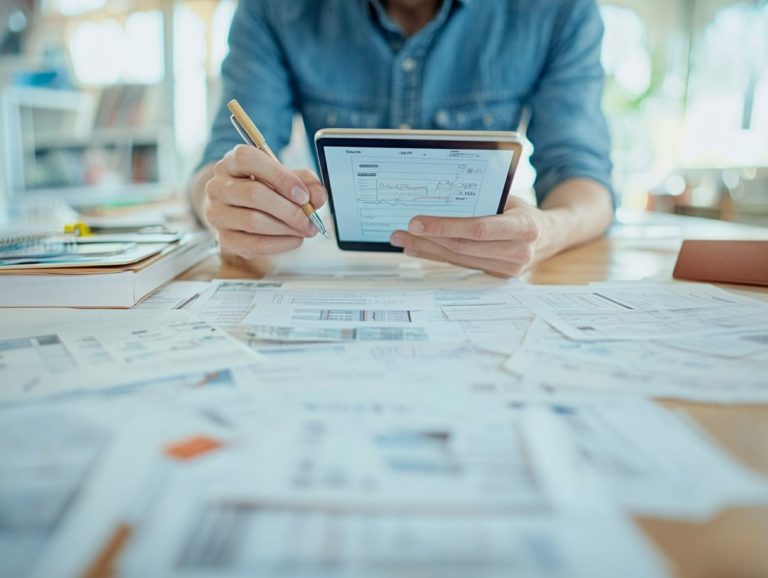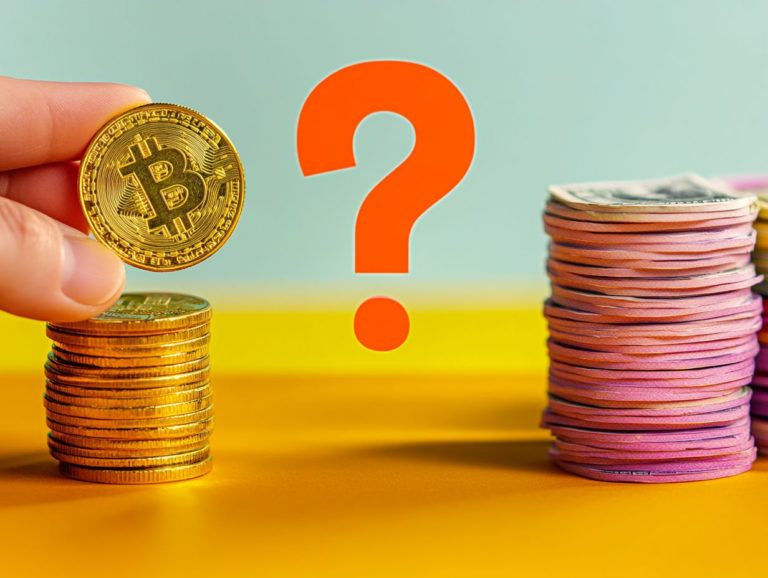Understanding the Value of Physical Silver
Investing in physical silver presents an intriguing journey for both seasoned investors and newcomers alike. This article unpacks the essentials, beginning with what physical silver is and the various forms it can take.
Delve into the numerous benefits of incorporating silver into your investment portfolio. From enhancing diversification to acting as a reliable hedge against inflation, you ll explore key factors that influence silver s value. You ll also discover practical tips for embarking on your adventure with this tangible asset.
Whether you seek to secure your financial future or are simply curious about the allure of silver, you’ll find valuable insights that can guide your investment journey.
Contents
Key Takeaways:
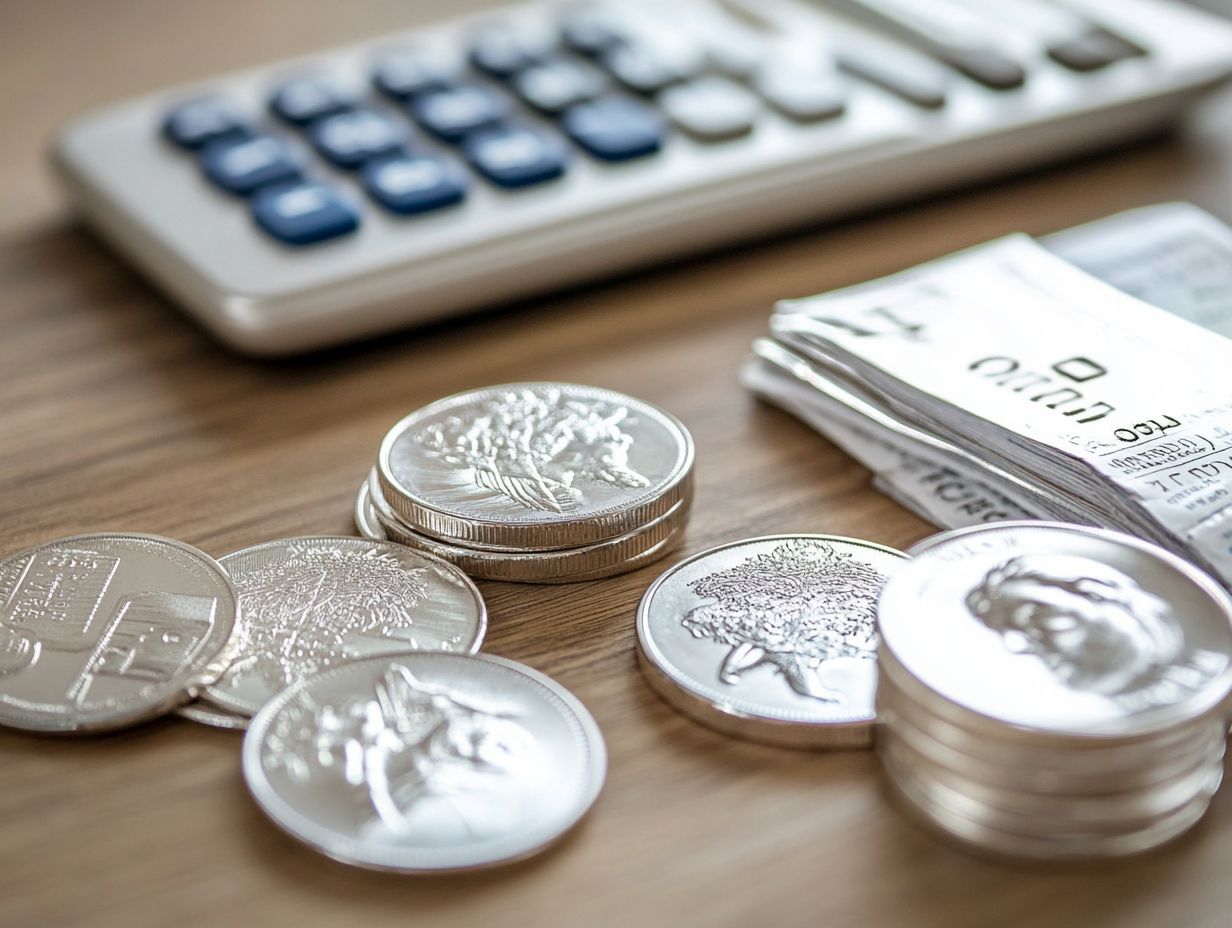
- Diversify your investment portfolio with physical silver to protect against inflation and economic instability.
- Physical silver offers stability and high liquidity, making it a reliable asset for long-term investment.
- Factors like supply, demand, and economic conditions can greatly impact the value of physical silver. Stay informed to make smart investment decisions.
The Basics of Physical Silver
Physical silver, a precious metal steeped in historical significance since 3000 B.C., is not only revered for its exquisite beauty in jewelry but also recognized as a strong investment option. It plays a crucial role across various industries, from technology to solar energy, making it a favored choice for investors aiming to hedge against inflation.
Over the decades, the trading landscape of silver has transformed, shaped by the ever-changing dynamics of supply and demand, economic conditions, and market prices. Understanding these complexities is essential for you as an investor navigating this intriguing market.
What is Physical Silver?
Physical silver is the tangible form of this precious metal, opening up a world of possibilities from crafting exquisite jewelry to serving as a robust investment asset.
Unlike silver-focused ETFs that represent shares in the silver market without the actual metal, physical silver offers a more direct and secure way to hold your value. Many investors gravitate toward this form during times of economic uncertainty, viewing it as a hedge against inflation and a smart way to diversify their portfolios. Understanding the market for physical assets can further enhance investment strategies.
What sets physical silver apart from many other investments is its intrinsic value, rooted in its utility across industries like electronics and solar energy. By incorporating physical silver into your investment strategy, you can enjoy the potential for appreciation while also relishing the satisfaction of possessing a tangible asset that has truly stood the test of time. To further understand the advantages of such investments, consider understanding the liquidity of physical assets.
Forms of Physical Silver
You can acquire physical silver in various forms, including silver coins, bullion bars, and exquisite jewelry, each catering to different needs for collectors and investors alike.
For instance, silver coins, often minted by governments, are not just popular for their historic value; they also offer you a tangible connection to diverse cultures. On the flip side, bullion bars, typically bought in larger quantities, attract those who seek a cost-effective way to invest in precious metals, as they generally come with lower premiums over the spot price. If you’re interested in specific coin types, learning how to evaluate the value of palladium coins can also be beneficial.
Then there’s silver jewelry, which presents a delightful blend of artistic design and craftsmanship, allowing you to enjoy both its aesthetic appeal and investment potential. By exploring these varied forms, you can align your choices with personal preferences and overall financial strategies, ensuring a holistic approach to accumulating wealth in this timeless metal.
Benefits of Investing in Physical Silver
Investing in physical silver offers a range of advantages that are enticing for both seasoned and novice investors alike. One of its standout features is its role as a diversification tool and a hedge against inflation.
As a precious metal with intrinsic value, silver tends to hold its ground in volatile markets, providing the liquidity you need during periods of economic uncertainty. With its historical significance and the rising demand for industrial applications, understanding how to assess the value of silver is crucial, as its allure is only increasing, positioning it as an attractive choice for anyone in search of tangible assets.
Diversification and Hedge Against Inflation
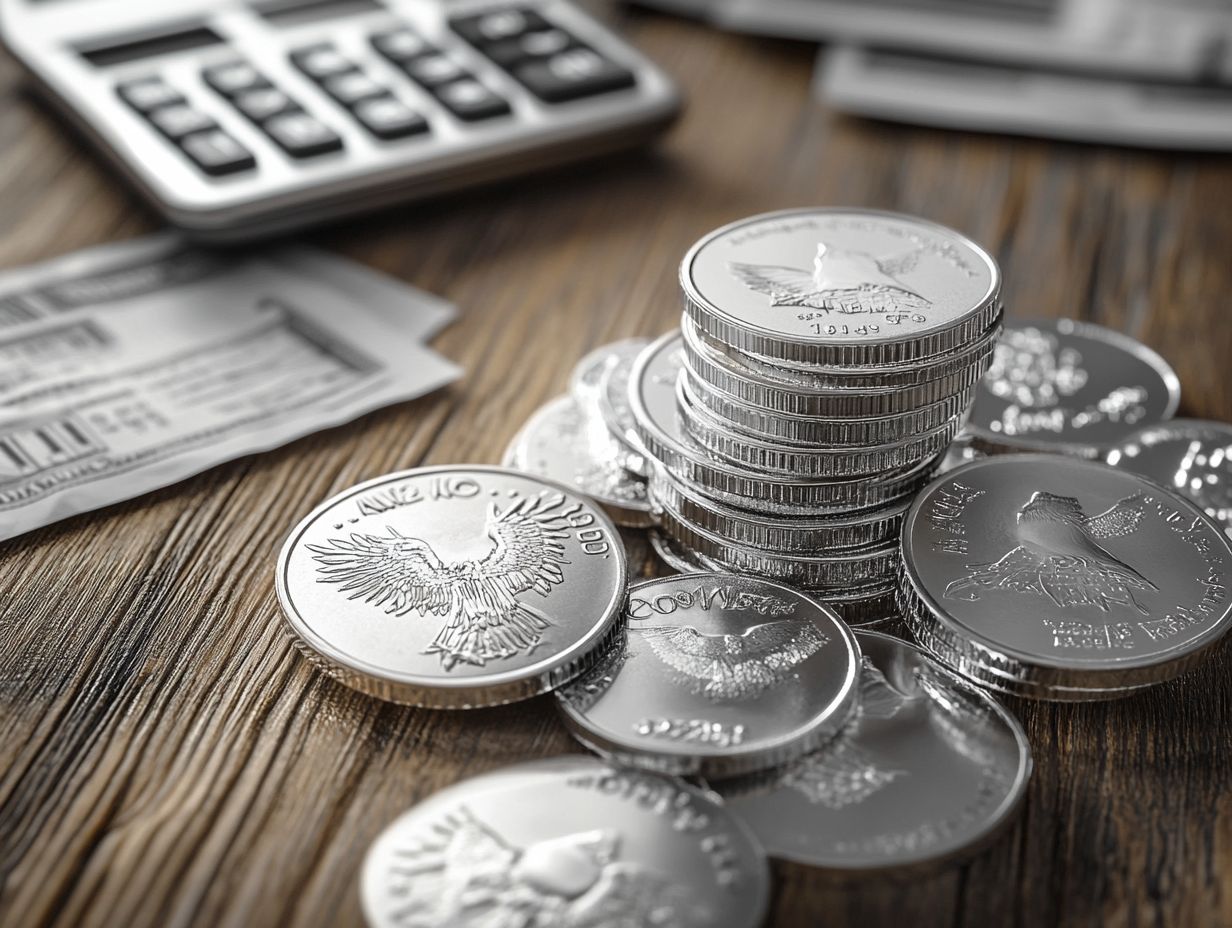
One of the key reasons you might consider investing in physical silver is its remarkable ability to diversify your portfolio and act as a hedge against inflation, particularly during uncertain economic times.
Historically, silver has shown impressive resilience during economic turbulence. It often maintains or increases its value when fiat currencies falter, which are government-issued money not backed by a physical commodity.
Take, for example, the 1970s: as inflation soared, silver prices surged, establishing itself as a safe haven for those cautious of the stock market’s unpredictable nature.
In today’s climate, with inflation rates on the rise and geopolitical uncertainties looming, many investors are turning to tangible assets like silver for protection. By integrating silver into your investment strategy, you can mitigate risks and seize potential gains, ultimately enhancing the stability of your overall portfolio.
Stability and Liquidity
Physical silver stands out for its stability and remarkable liquidity, making it an excellent choice for investors seeking to navigate the unpredictable twists and turns of the market. This precious metal often preserves its value when other assets stumble, offering you a safety net during economic downturns.
You’ll love how easy it is to buy and sell silver, giving you quick access to cash when you need it most. Trading trends reveal that demand for physical silver tends to surge during periods of inflation or market volatility, solidifying its reputation as a reliable asset. Understanding the costs of physical asset storage is also crucial to making informed investment decisions.
As central banks and institutional investors increasingly acknowledge the importance of diversification, silver s unique qualities empower you to safeguard your wealth while seizing opportunities in changing market dynamics.
Factors Affecting the Value of Physical Silver
The value of physical silver is shaped by a complex relationship of factors, primarily guided by the principles of supply and demand. Broader economic and political conditions also play a significant role in influencing market prices.
Understanding these dynamics can provide valuable insights into the silver market.
Supply and Demand
The interaction of supply and demand is essential in shaping the market prices of physical silver, influencing both its accessibility and investment potential.
Numerous factors significantly affect this dynamic, including mining output, which has experienced fluctuations due to environmental regulations and geopolitical issues that impact production. Silver’s industrial applications, especially in the electronics and renewable energy sectors, generate ongoing demand that can shift with technological advancements.
Market trends, shaped by global economic conditions and investor sentiment, also contribute to these price fluctuations. For instance, the surge in demand in 2020, driven by increased solar panel production, highlighted how industrial use can elevate silver’s market value.
Grasping these elements is vital for anyone contemplating an investment in this precious metal.
Economic and Political Factors
Economic and political factors wield substantial influence over the market for physical silver, shaping its prices and overall demand as investors respond to global events.
For example, during periods of economic uncertainty like the 2008 financial crisis you may have noticed a surge in demand for silver, as investors sought safe-haven assets, driving prices to unprecedented heights. Recent geopolitical tensions, including trade disputes and unrest in major economies, have also led to notable fluctuations in the silver market.
Many investors gravitate toward physical silver as a hedge against inflation and currency depreciation, especially when central banks announce shifts in monetary policy. Understanding these dynamics empowers you to make informed investment decisions, as historical trends often illuminate potential future movements in silver valuations.
Ready to diversify your portfolio? Start your silver investment journey today!
How to Start Investing in Physical Silver
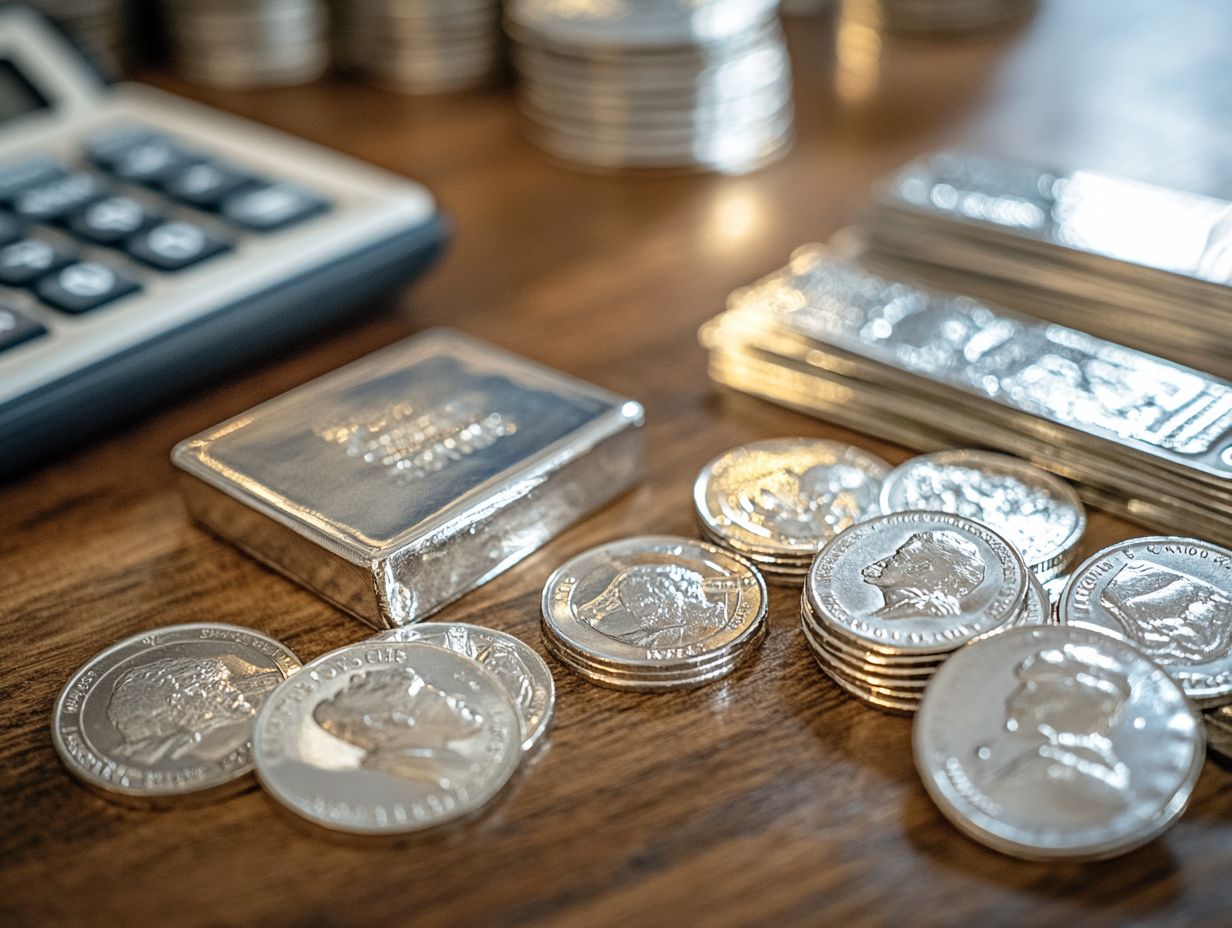
Investing in physical silver can be both thrilling and rewarding! However, familiarizing yourself with the different investment types such as coins, bullion, and ETFs (Exchange Traded Funds) can significantly ease the process for you as a beginner.
Types of Silver Investments
You have several enticing options when it comes to silver investments, including physical silver coins, bullion bars, and silver ETFs. Each option caters to various investment strategies.
If you re drawn to tangible assets, physical silver like coins and bullion bars might be what you want. They offer personal ownership and control, but you ll need to consider the logistics of storage and insurance.
On the other hand, silver ETFs provide a more liquid avenue. They allow you to engage in the silver market without the hassle of physical storage, though management fees may apply.
If you’re feeling adventurous, silver mining stocks can provide exposure to silver’s price fluctuations, although they also introduce operational risks associated with the companies.
Each investment option has its unique advantages and drawbacks. It s crucial to evaluate your individual investment goals and risk tolerance before diving in.
Tips for Beginners
Ready to dive into the silver market? For beginners looking to invest in physical silver, having actionable tips can be your guiding light in navigating the market effectively.
Understanding market trends and conducting thorough research is essential for making informed decisions. Start by familiarizing yourself with the various forms of silver available, like bullion coins and bars, and recognize reliable dealers. Additionally, learn how to calculate the value of your precious metals to enhance your investment strategy.
Analyzing the market trends helps you make informed choices. As you embark on this journey, be aware of common pitfalls, such as overpaying for premiums or overlooking storage costs. Staying vigilant and informed throughout your investment adventure is key.
Frequently Asked Questions
What is physical silver?
Physical silver refers to silver in its physical form, such as bars, coins, or other tangible objects. It is the direct representation of silver as a precious metal.
Why is physical silver valuable?
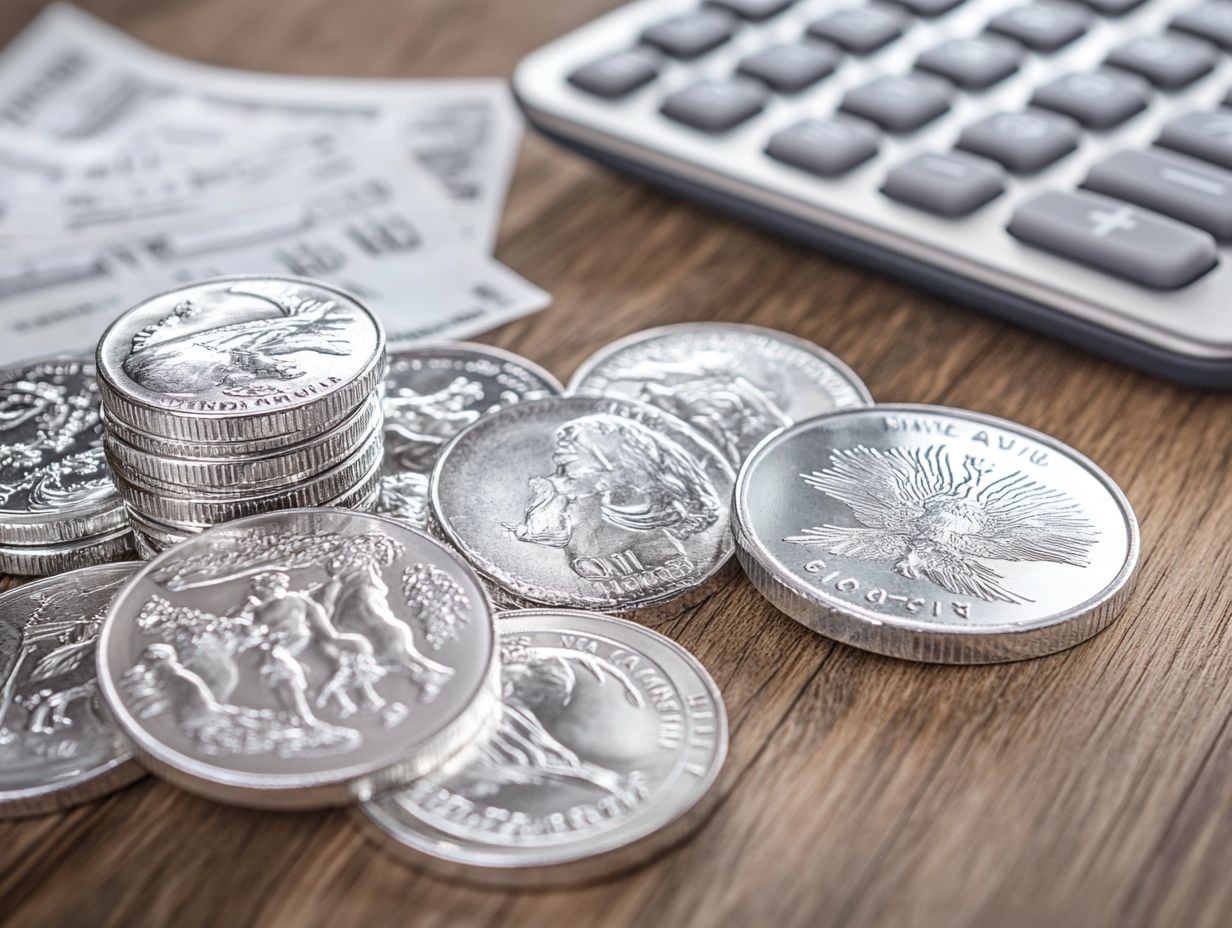
Physical silver is valuable because it is a precious metal with a wide range of industrial and commercial uses. It is also considered a safe haven investment and a hedge against inflation and economic instability.
How is the value of physical silver determined?
The value of physical silver is influenced by various factors, including supply and demand, economic conditions, and market speculation. The spot price of silver, which is its price for immediate delivery, plays a significant role in determining its value.
What are the advantages of investing in physical silver?
- Liquidity
- Tangible form
- Potential for long-term growth
- More affordable compared to gold
What are the risks associated with investing in physical silver?
Investing in silver comes with risks, like price changes and economic issues. It’s vital to conduct thorough research and work with a reputable dealer.
How can I determine the authenticity of physical silver?
To ensure the authenticity of physical silver, purchase from a trusted and reputable dealer. You can also perform simple tests, like the magnet test or the ice test, to check for the presence of other metals. For additional assurance, have your silver items tested by a professional assayer.
Begin your silver investment journey now!










